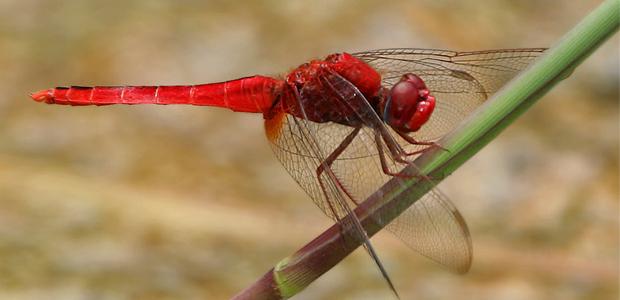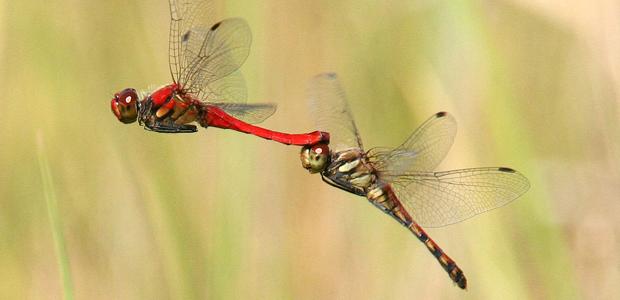A team of Japanese researchers have identified the pigments that give dragonflies their scarlet hue.
It’s as predictable as the changing season and late every summer, male dragonflies sexually mature and their body colour changes from bright yellow to an even more vibrant, ruby red one.
Since the brightly coloured insects have become a ubiquitous symbol in Japanese culture – they’re immortalized in songs, poems and on many forms of art – a team of Japanese biologists set out to find what gives the male dragonflies their colour and how it changes to reveal the scarlet hue.
“Dragonflies are very popular insects in Japan and red dragon flies are very famous,” Ryo Futahashi, study co-author and biologist at the National Institute of Advanced Industrial Science and Technology in Japan, told Science-Fare.com.
The researchers looked at three species of dragonfly known to undergo the dramatic yellow-to-red transformation at sexual maturation – known scientifically as nuptial colouration. Both, Sympetrum darwinianum and S. frequens, turn a cinnamon red colour, while Crocothemis servilia acquires an even brighter, ruby colour.
When they analyzed the insects skin tissues, the pigments they found were similar to a group known to give some crustaceans and other insects, like fruit flies, colour too.
“Both the red and yellow pigments of dragonflies are ommochrome pigments,” Futahashi said.
When they compared the male pigments, the researchers found they were all the same – which is why they’re all red – but, the ruby coloured dragonfly contained a second pigment that differed just by the addition of a single chemical group, known as a carboxyl group.
Females of all three species also had the decarboxylated form of the pigment – the version lacking the carboxyl group.
This means the change in colour is because of a shift within the pigment – there’s nothing added or removed, like a carboxyl group, but it’s changed slightly.
These cool types of reactions are known as redox reactions. In order to change colour, an electron is transferred instead of a chemical group. The electron triggers an internal cascade – like tumbling dominos – and that changes the pigment enough to change the colour.
Different researchers have shown other ommochrome pigments behave like this. In order to confirm that was the case here, researchers treated the cells with a natural reductant and oxidant – hence the reaction being named a redox reaction.
When they treated the yellow pigments with vitamin C, they turned red. This is because vitamin C – also known as ascorbic acid – gives one of its electrons to the pigment, triggering the internal cascade. It’s known as the reductant and reduces the pigment by giving it an electron.
When they treated the red pigments with sodium nitrite, the colour reversed back to yellow because it took an electron from the pigment, reversing the internal cascade. It’s known as the oxidant and oxidizes the pigment by taking an electron.
When the researchers injected vitamin C directly into yellow pigmented dragonflies, both female and males that hadn’t reached sexual maturity developed the red, cinnamon colour characteristic of their sexually mature, male counterpart – males that had both pigments developed the vibrant, crimson colour.
This directly showed the researchers that it was a redox reaction that drove the colour-change. But, they still didn’t know what the reductant was.
When they factored out vitamin C – a common biological reductant and likely first candidate – there was still something present that could reduce the pigment. What that something could be though, is the subject of future experiments – they just know it’s not vitamin C.
When researchers examined S. frequens dragonflies that were gynandromorphic – this is a phenomenon in insects where some cells of one dragonfly are male and others are female – the red pigment showed up in irregular patches.
“Maybe a mature male has some specific enzyme that reduces the pigment specifically,” Futahashi said. Because the red shows up patchy in the gynandromorphic dragonflies, he thinks it’s probably an enzyme that’s cell specific and doesn’t move between cells. These are known as intracellular enzymes.
Both fruit flies and butterflies use enzymes in order to reduce their pigments – or prevent them from being oxidized – so it’s not a stretch to think this could be the case here.
Whatever it is, it may have an additional benefit since the insects are diurnal – they’re active during the day. Reductants are more commonly known as antioxidants and it could help protect against the oxidative damage caused by the sun.
Either way, their colour’s especially important for determining who’s who – especially when it comes to mating.
“Dragonflies are diurnal and recognize each other by visual cue,” Futahashi said. They’re also incredibly territorial once they reach sexual maturity and their colour helps them distinguish females and harmless, juvenile males, from other combative males.
Not all species of dragonfly change from yellow-to-red though. Some species of dragonfly change from yellow-to-blue while others change from red-to-green upon sexual maturation – and Futahashi hopes to study what causes those pigments to change too.
This gem of a discovery was published in the journal, Proceedings of the National Academy of Sciences.
 Science Fare Media Science News – Upgraded
Science Fare Media Science News – Upgraded



